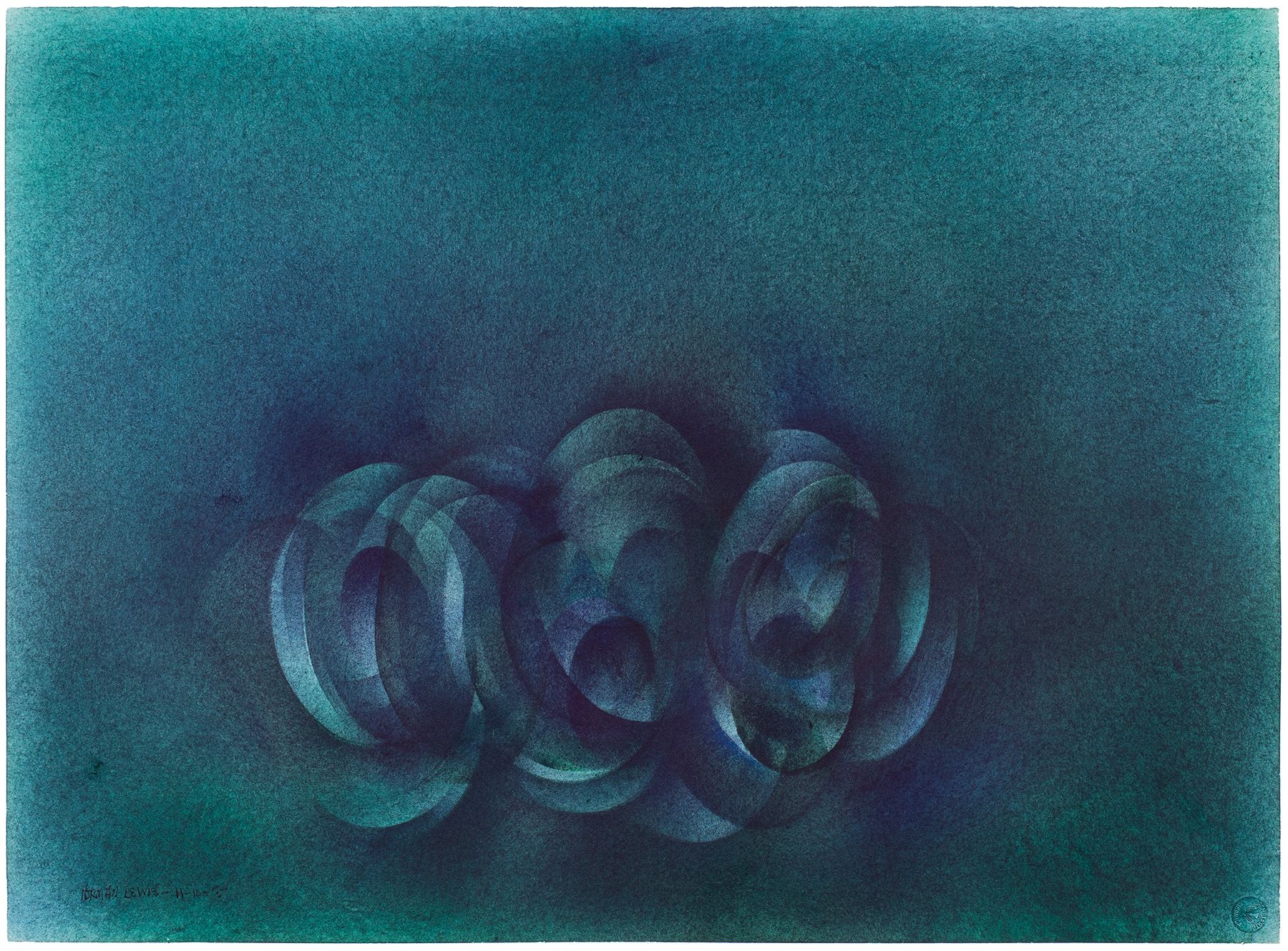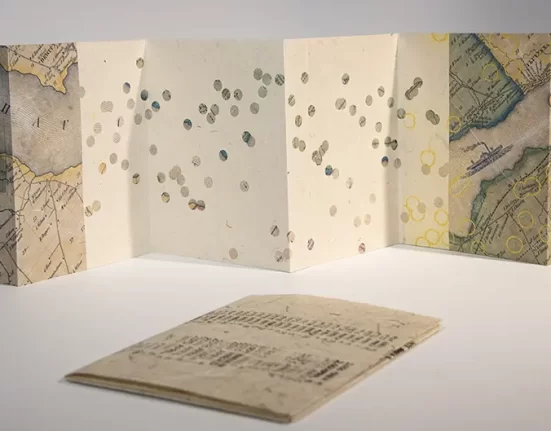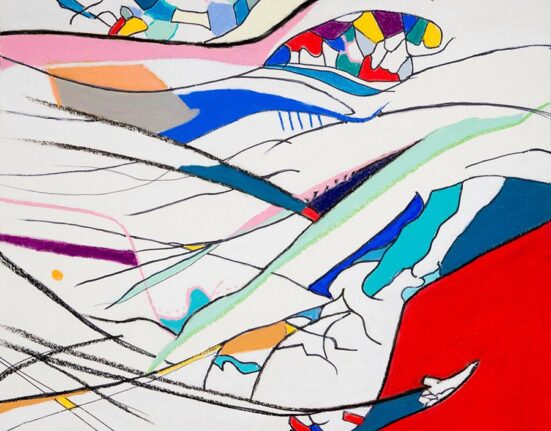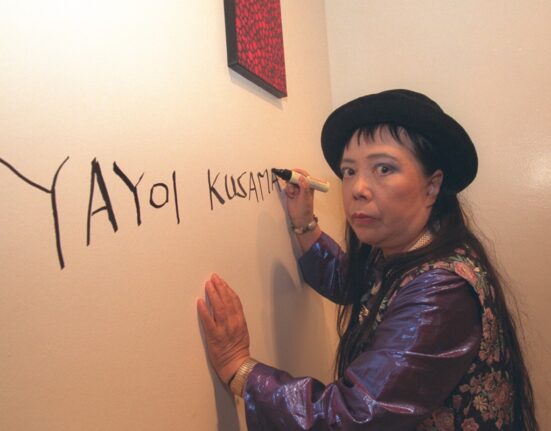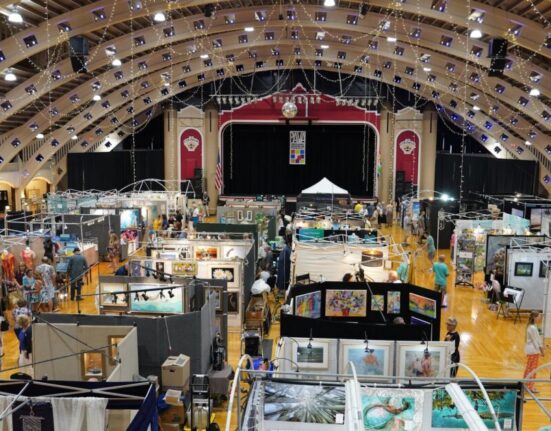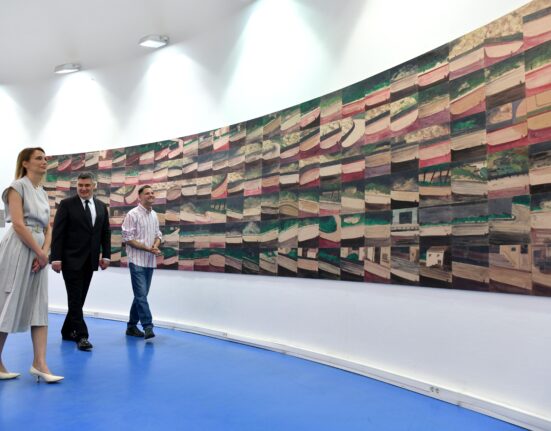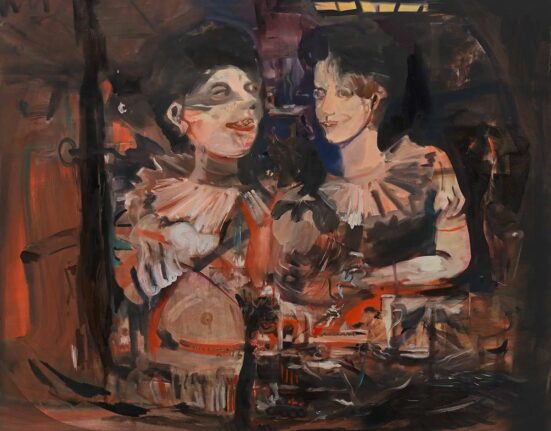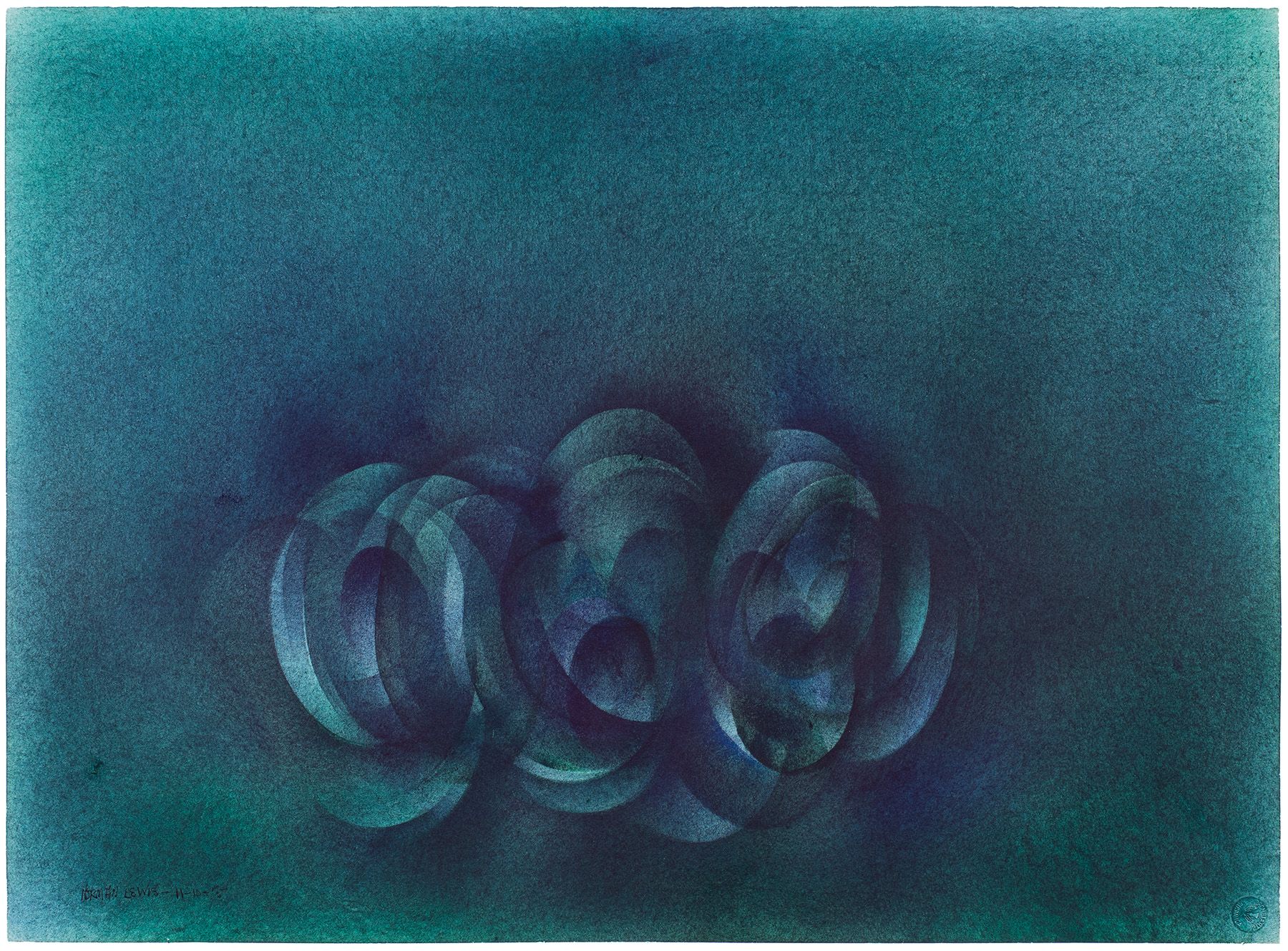

NORMAN LEWIS (1909–1979), “Untitled (Seachange),” 1975 (oil on paper, 22 x 30 inches / 55.9 x 76.2 cm, signed). | © Estate of Norman Lewis. Courtesy of Michael Rosenfeld Gallery LLC, New York, N.Y.
CELEBRATED FOR PRODUCING large abstract paintings, Norman Lewis (1909–1979) made transcendent pictures. His moody and dramatic canvases are full of movement with organic fog, cloud-like forms, and delicate and mysterious straight and meandering lines. Some paintings evoke dense atmospheres punctuated with striking color achieved with intentional mark making or improvisational bursts that call to mind free-falling confetti. More spare compositions were defined by marks with calligraphic references. Others feature tiny, loosely rendered or hieroglyphic-style figures that appear to be marching in procession across his compositions.
These same styles and techniques are evident in the hundreds of works on paper Lewis produced throughout his career. Over the years, the artist made works on paper employing a variety of mediums, including ink, pastel, graphite, crayon, watercolor, oil, and gouache, sometimes using multiple drawing or painting mediums in one work. In most cases, his works on paper were stand-alone creations and not studies for more finished works or paintings.
“Norman Lewis: Give Me Wings To Fly” at Michael Rosenfeld Gallery in New York presents 60 works on paper, dating from 1937 to 1978. As the gallery notes, the works on view “collectively trace the major developments of the artist’s visual language and reveal his immense range in subject…”
Works on paper by Norman Lewis “collectively trace the major developments of the artist’s visual language and reveal his immense range in subject…”
The sole Black member of the New York School of Abstract Expressionism, Lewis was active in the mid-19th century alongside Willem de Kooning, Jackson Pollock, and Mark Rothko. Despite being an active participant in the intellectual movement, he was not afforded the same opportunities as his white peers in his lifetime. The first comprehensive museum retrospective of Lewis was organized more than three decades after his death. “Procession: The Art of Norman Lewis” was curated by Ruth Fine in 2015 and traveled to Amon Carter Museum of American Art in Fort Worth, Texas, and the Chicago Cultural Center.
Fine worked at the National Gallery of Art from 1972 to 2012, spending more than two decades of her tenure as the museum’s first curator of modern prints and drawings. She authored a new essay about Lewis’s works on paper for the fully illustrated, digital catalog published to accompany the exhibition.
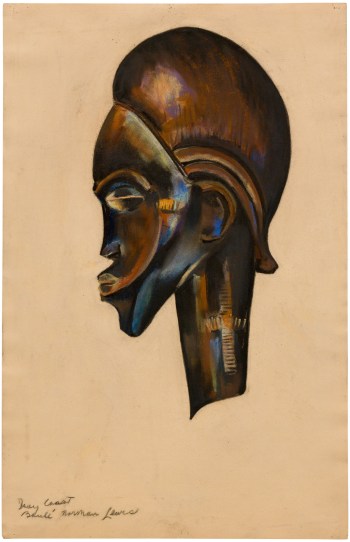

NORMAN LEWIS (1909–1979), “Ivory Coast Baule,” 1935 (pastel on sandpaper, 22 x 14 1/4 inches / 55.9 x 36.2 cm, signed). | © Estate of Norman Lewis. Courtesy of Michael Rosenfeld Gallery LLC, New York, N.Y.
THE ESSAY IS BRIMMING with insights, observations, and scholarship about Lewis, his practice, and the many works on paper on view. Selections from a series of 1935 pastel on sandpaper drawings of African sculptures are the earliest works in the show. The six drawings are based on objects featured in “African Negro Art” (1935) at the Museum of Modern Art (MoMA). Organized by MoMA director Alfred H. Barr and curator James Johnson Sweeney, the exhibition included more than 600 works, both figurative sculptures and masks. Lewis made the drawings in the museum’s galleries working directly from the objects.
“It seems clear it was the rough surface rather than the sandy color that attracted him, given that in most of the known drawings, the color is at least partially hidden by a pastel field surrounding the African sculpture rendered there,” Fine wrote. “Lewis’ skill as a draftsperson is evident in the richly detailed dimensionality he imparts to the African sculptures, while the sandpaper support adds significantly to the object-like character of the image-objects he was depicting.”
The World War II era was a transitional period for the New York artist. “Importantly, Lewis was moving forward to demonstrate his belief that the struggle for racial justice in the United States was best fought through his actions—not in his art, where he was primarily preaching to the choir,” Fine wrote. “As it turned out, he fought and commented in both arenas, but his activist stance in the world was more explicit than his reportage about racism in his art, especially in the works on paper.”
In terms of the struggle for racial justice in the United States, Norman Lewis “fought and commented in both arenas, but his activist stance in the world was more explicit than his reportage about racism in his art, especially in the works on paper.” — Ruth Fine
He evolved away from figuration and social realism moving toward abstraction, along the way exploring architectural forms and interior space. Four architectural works are included in the exhibition.
Born in Harlem, worked intermittently as a seaman on freighter in his early 20s, traveling to Bolivia, St. Thomas, Jamaica, Montevideo, between 1929 and 1932. Later in life, his international travels included Spain and North Africa.
As his artistic practice developed over the decades, he took advantage of opportunities to spend time outside the city. The sojourns inspired some of the natural and atmospheric references to seascapes, fog, and seasonal changes in his work.
Fine described the opportunity to visit Marian Willard’s Long Island home as one of the “benefits” of joining her gallery. “Marian Willard was known to seek advanced art, embracing various approaches to abstraction, at a time when conservatism continued to dominate New York’s gallery scene, and even its museums,” she wrote.
Located in Locust Valley on the North Shore, Willard’s country home had a pond on the property and was in close proximity to the beach and Long Island Sound. A change of scenery would continue to inspire him in later years. In 1973, Lewis and his future wife Ouida Bramwell Williams traveled to Greece, where he visited his friend, artist Jack Whitten (1939-2018) and his wife, for three months at their summer home in Crete. Fine also pointed to time Lewis spent on Block Island, off the coast of Rhode Island in 1976, as having a positive influence on his productivity.
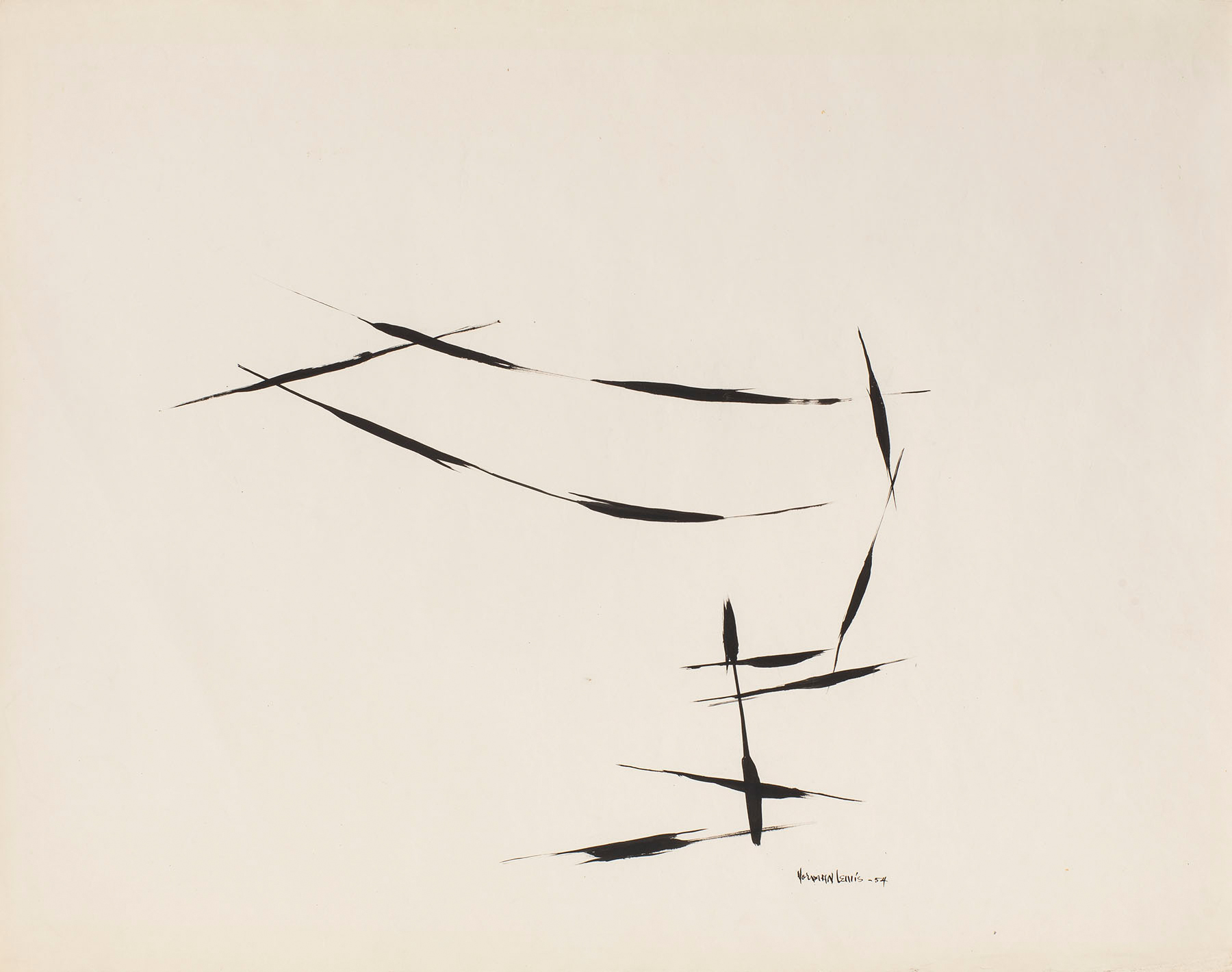
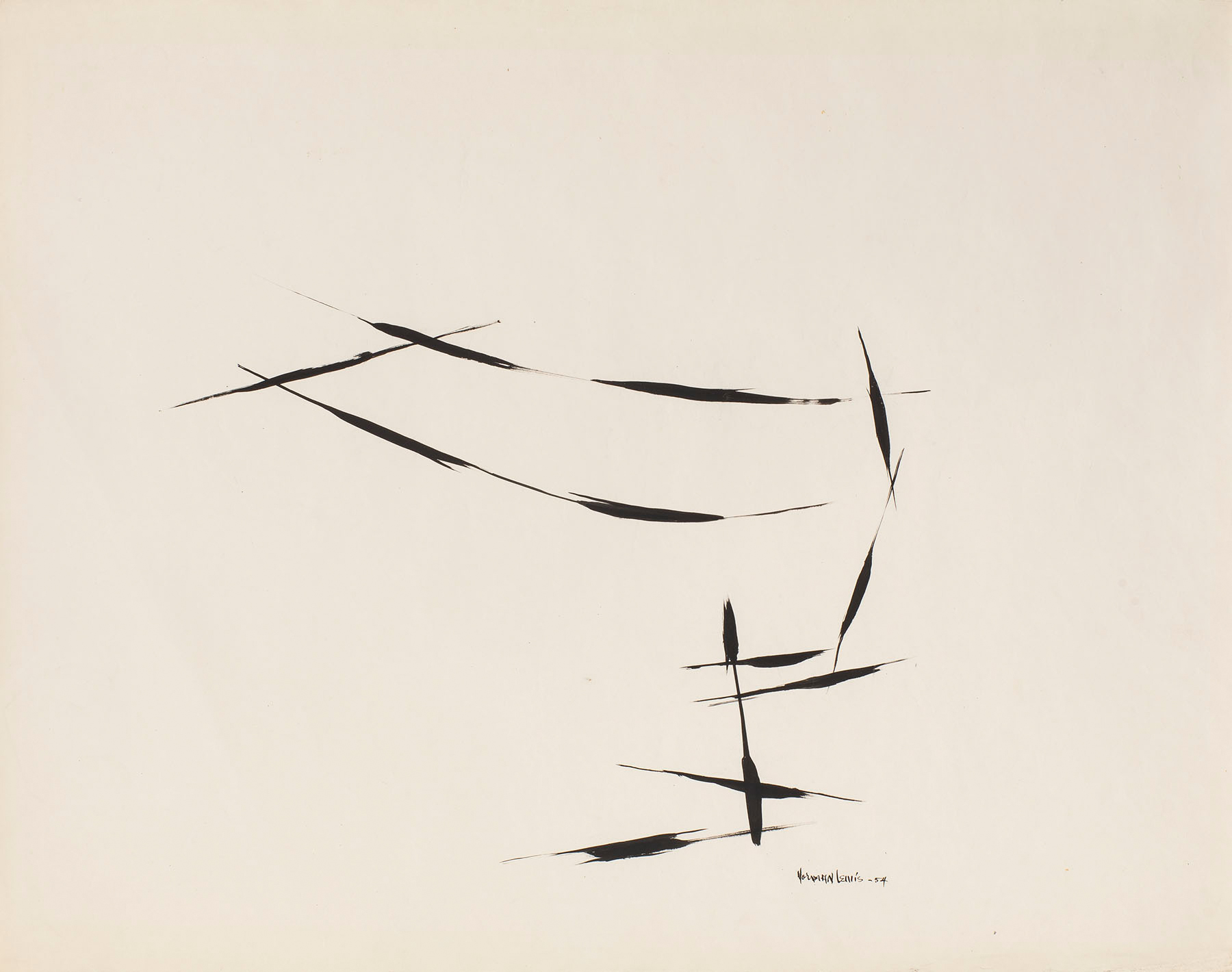
NORMAN LEWIS (1909–1979), “Give Me Wings to Fly No!,” 1954 (ink on paper, 19 x 24 inches / 48.3 x 61 cm, signed). | © Estate of Norman Lewis. Courtesy of Michael Rosenfeld Gallery LLC, New York, N.Y.
THE TITLE OF THE EXHIBITION is drawn from an ink drawing (“Give Me Wings to Fly No!,” 1954), a minimalist work composed of simple marks that together evince the outlines of an avian form with an outstretched wing. Fine suggested that Dreams, a 1923 poem by Langston Hughes, was the inspiration for the title. A convincing connection can be found in the third and fourth lines of the brief poem:
References to music, specifically jazz, are often made in considerations of Lewis’s work, as a subject and in terms of its improvisational manner. Fine also mentions gambling in this respect. “Lewis spoke frequently about how gambling—pool, poker, and the racetrack—enabled him to cover expenses throughout his life, starting with the building of his library,” Fine wrote. “A gambler’s instinct seems to be in play in much of his work: make a move and see what happens. This approach can likewise be attributed to his love for jazz music at its most improvisatory moments: do something, react to what’s done, and then react again.”
“A gambler’s instinct seems to be in play in much of his work: make a move and see what happens. This approach can likewise be attributed to his love for jazz music at its most improvisatory moments: do something, react to what’s done, and then react again.” — Ruth Fine
The essay weaves many more highlights of Lewis’s biography with details of his evolving practice in terms of his works on paper, his role as a teacher, and enduring desire to learn. He assembled an extensive library of books, regularly visited museums and galleries, was active in several groups and communities focused on Black artists and across racial lines, and engaged individually with many artists, both mentors and peers.
Fine notes the types of paper Lewis used and the characteristics and qualities of the various substrates; the many processes and methods he worked with, including layering, rubbing, masking, dragging and scratching; and his affinity for a spectrum of blues, which dominated his works in the last two decades of his life.
In conclusion, Fine wrote that “the importance of Norman Lewis’s works on paper is their experimentation with materiality and formal ideas; their lack of immediate consistency, our inability to silo them because they are without boundaries and beyond categorization. They are visually unique, intellectually demanding, and extremely beautiful in the deliberateness of their hybridity and ambiguity.” CT
“Norman Lewis: Give Me Wings To Fly” is on view at Michael Rosenfeld Gallery in New York, N.Y., from Sep. 7-Nov. 4, 2023
READ MORE A digital exhibition catalog published to accompany “Norman Lewis: Give Me Wings To Fly” features a new essay authored by Ruth Fine
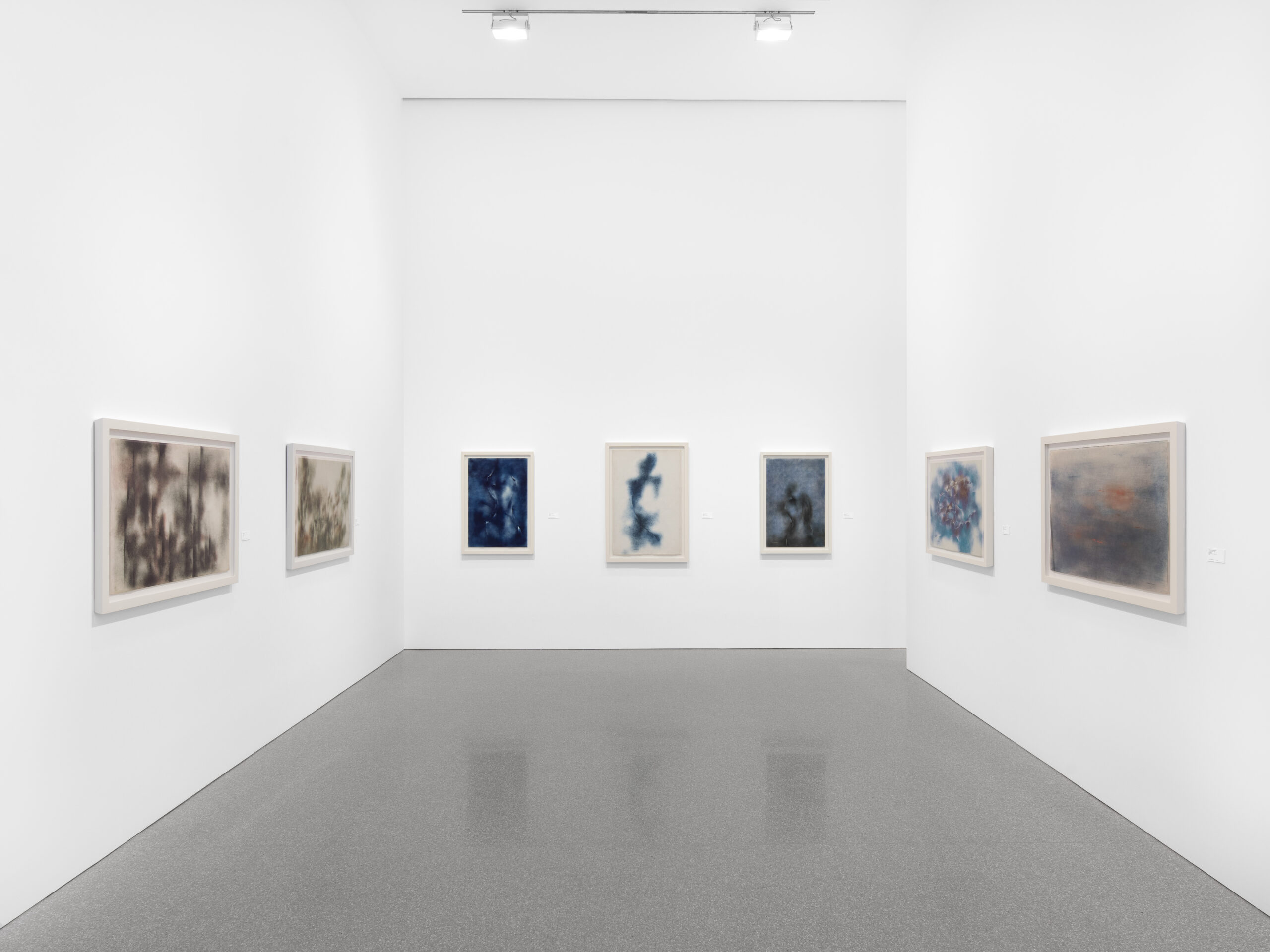

Installation view of “Norman Lewis: Give Me Wings To Fly” at Michael Rosenfeld Gallery, New York, N.Y. (Sept. 7-Nov. 4, 2023). | Courtesy Michael Rosenfeld Gallery
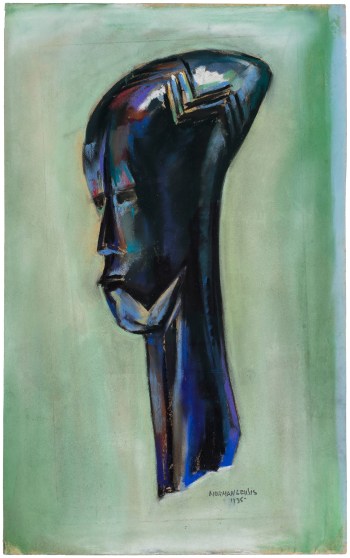

NORMAN LEWIS (1909–1979), “Carved Bobbin (Guru),” 1935 (pastel on sandpaper, 14 x 8 3/4 inches / 35.6 x 22.2 cm, signed). | © Estate of Norman Lewis. Courtesy of Michael Rosenfeld Gallery LLC, New York, N.Y.

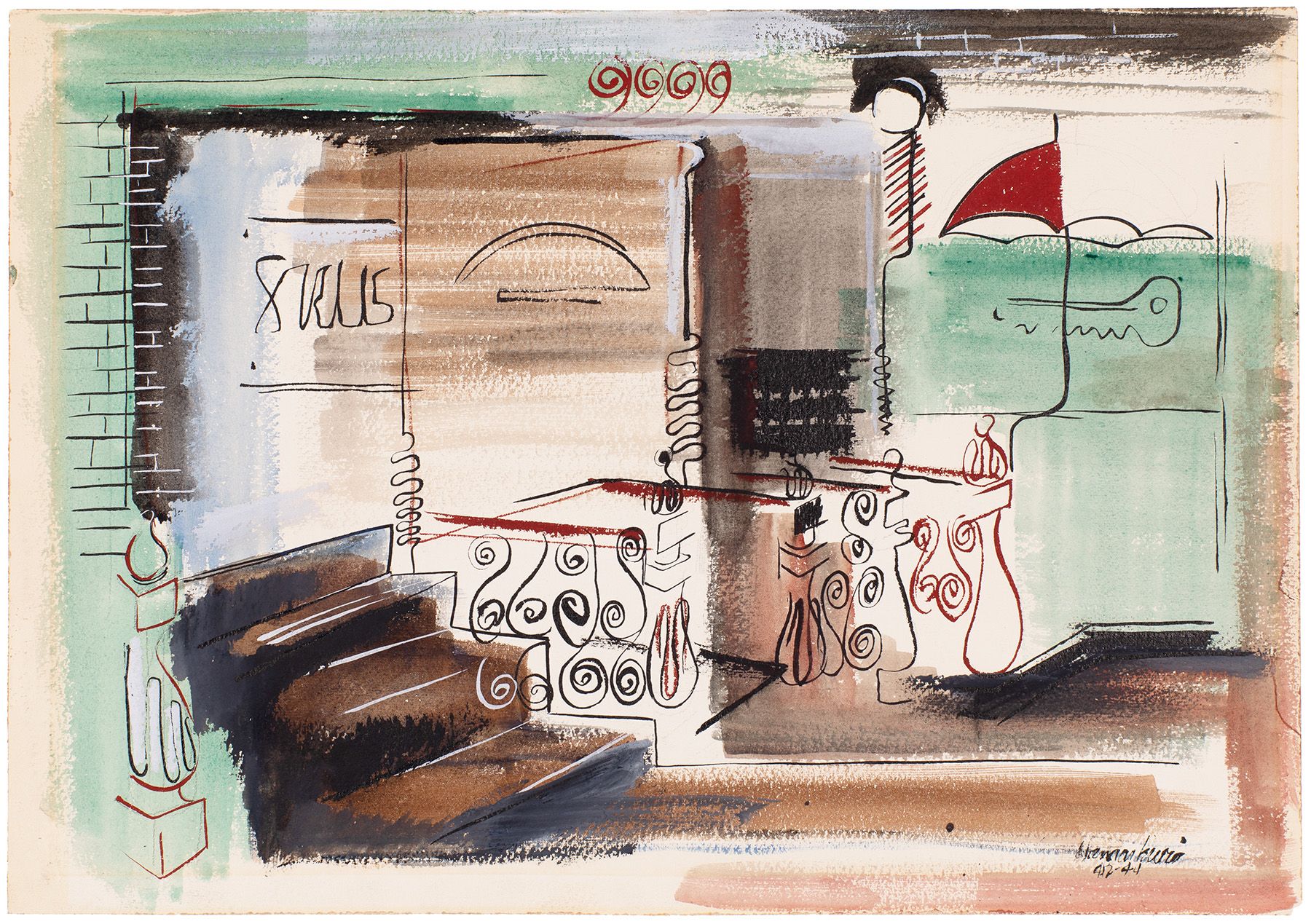
NORMAN LEWIS (1909–1979), Untitled, 1944 (watercolor, gouache and ink on paper, 14 x 20 inches / 35.6 x 50.8 cm, signed). | © Estate of Norman Lewis. Courtesy of Michael Rosenfeld Gallery LLC, New York, N.Y.


NORMAN LEWIS (1909–1979), Untitled, 1950 (ink on paper
19 x 24 inches / 48.3 x 61 cm, signed). | © Estate of Norman Lewis. Courtesy of Michael Rosenfeld Gallery LLC, New York, N.Y.

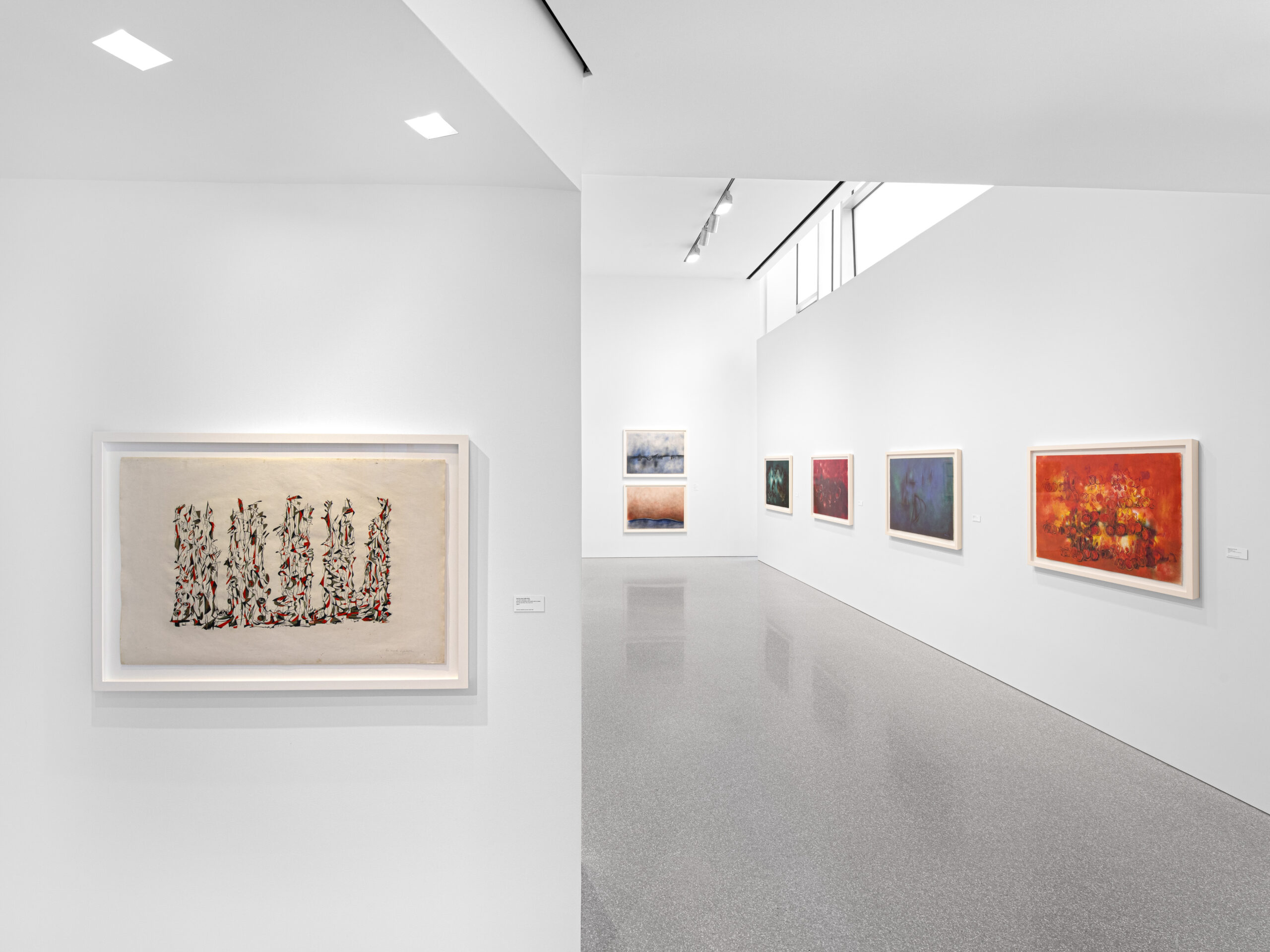
Installation view of “Norman Lewis: Give Me Wings To Fly” at Michael Rosenfeld Gallery, New York, N.Y. (Sept. 7-Nov. 4, 2023). | Courtesy Michael Rosenfeld Gallery
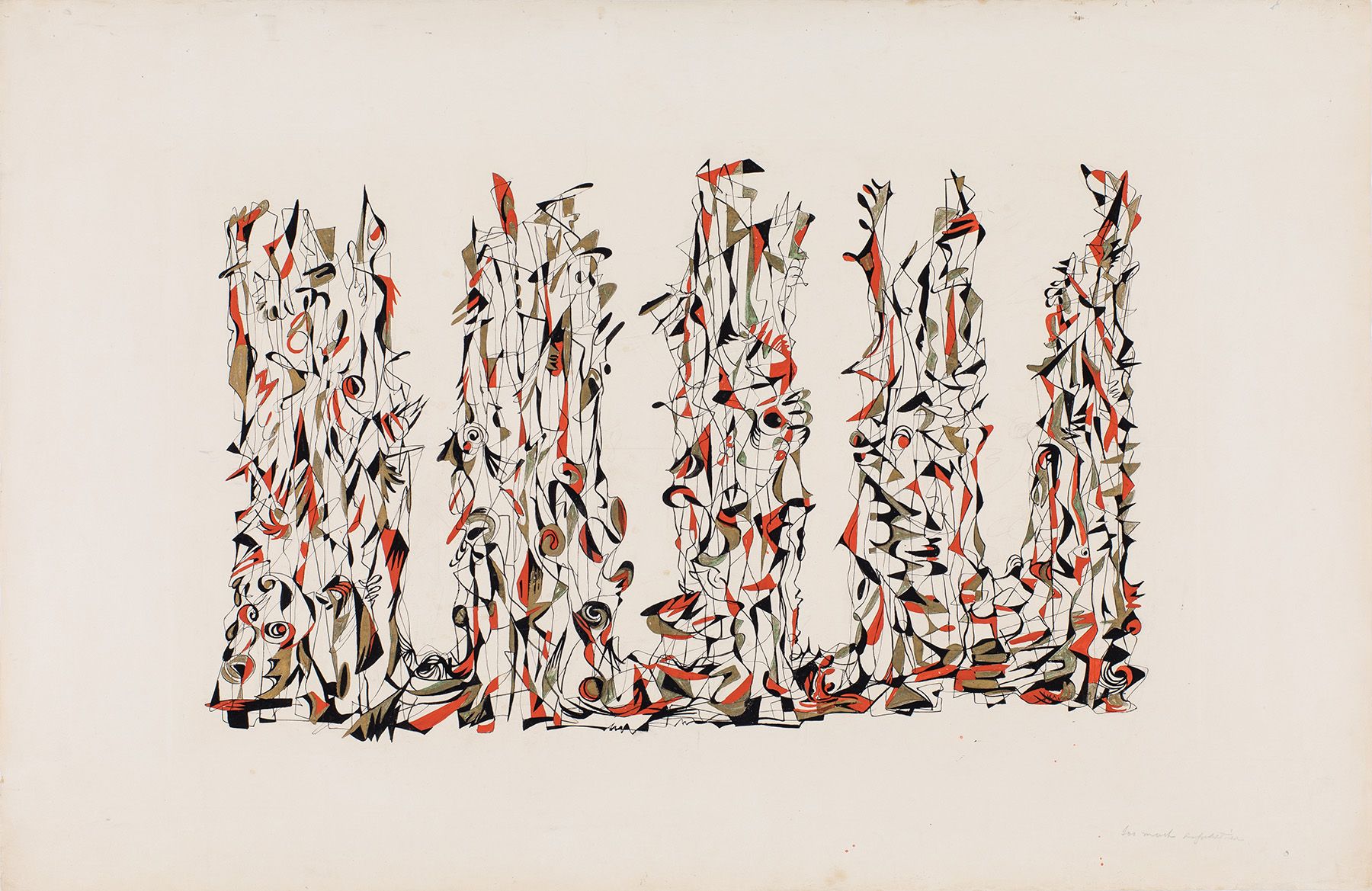

NORMAN LEWIS (1909–1979), “Too Much Aspiration,” circa 1953 (gouache, ink, graphite and metallic paint on paper, 26 x 40 1/8 inches / 66 x 101.9 cm, signed). | © Estate of Norman Lewis. Courtesy of Michael Rosenfeld Gallery LLC, New York, N.Y.
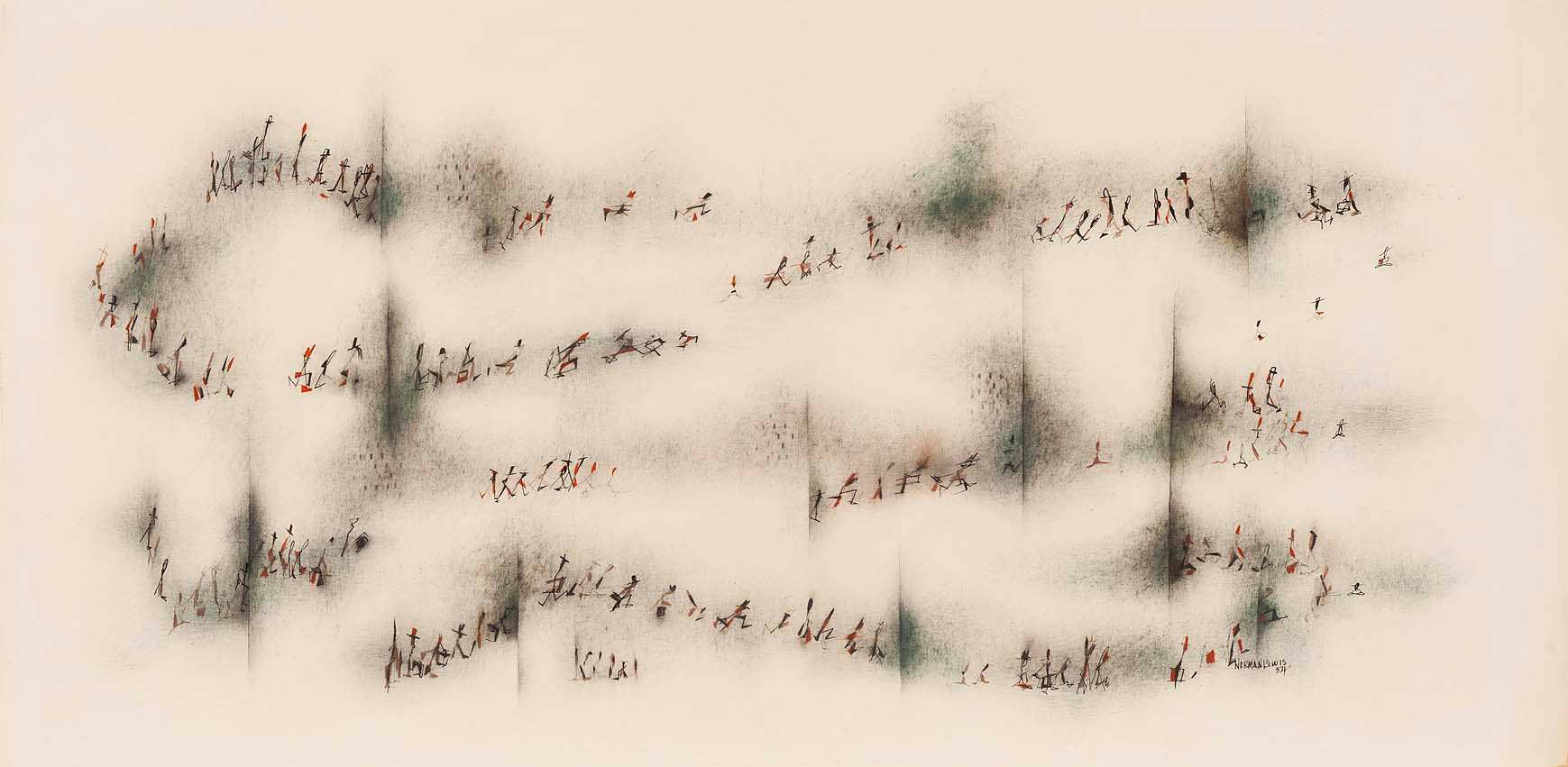

NORMAN LEWIS (1909–1979), “Commuters,” 1954 (oil and ink on paper, 19 1/4 x 38 1/2 inches / 48.9 x 97.8 cm; 18 3/8 x 37 3/8 inches / 46.7 x 94.9 cm sight size, signed). | © Estate of Norman Lewis. Courtesy of Michael Rosenfeld Gallery LLC, New York, N.Y.
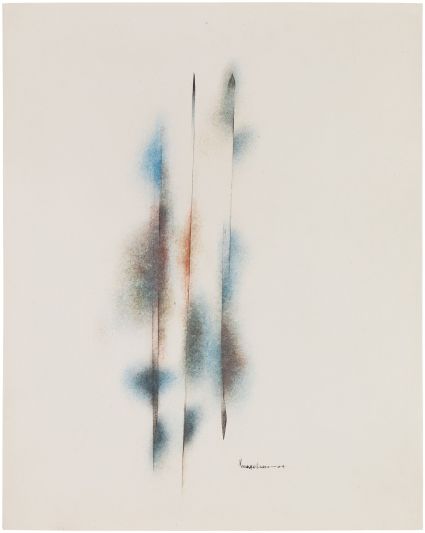

NORMAN LEWIS (1909–1979), “Elemental Regions,” 1954 (oil and ink on paper, 24 x 19 1/4 inches / 61 x 48.9 cm, signed). | © Estate of Norman Lewis. Courtesy of Michael Rosenfeld Gallery LLC, New York, N.Y.
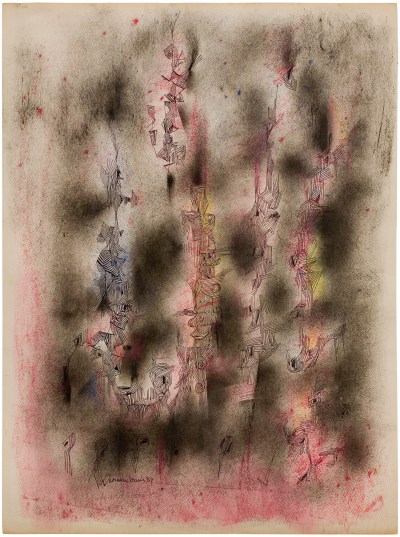
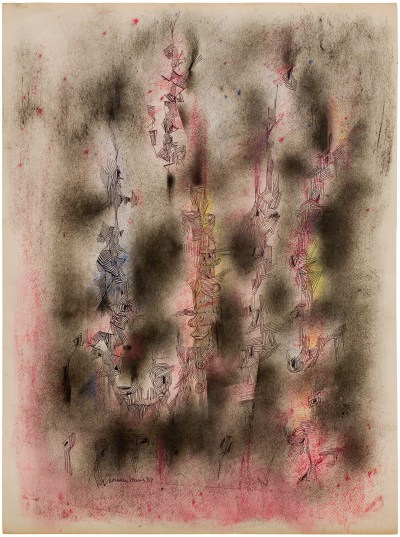
NORMAN LEWIS (1909–1979), “Carnaval Totem,” 1959 (crayon, pastel and ink on paper, 24 x 17 3/4 inches / 61 x 45.1 cm, signed). | © Estate of Norman Lewis. Courtesy of Michael Rosenfeld Gallery LLC, New York, N.Y.

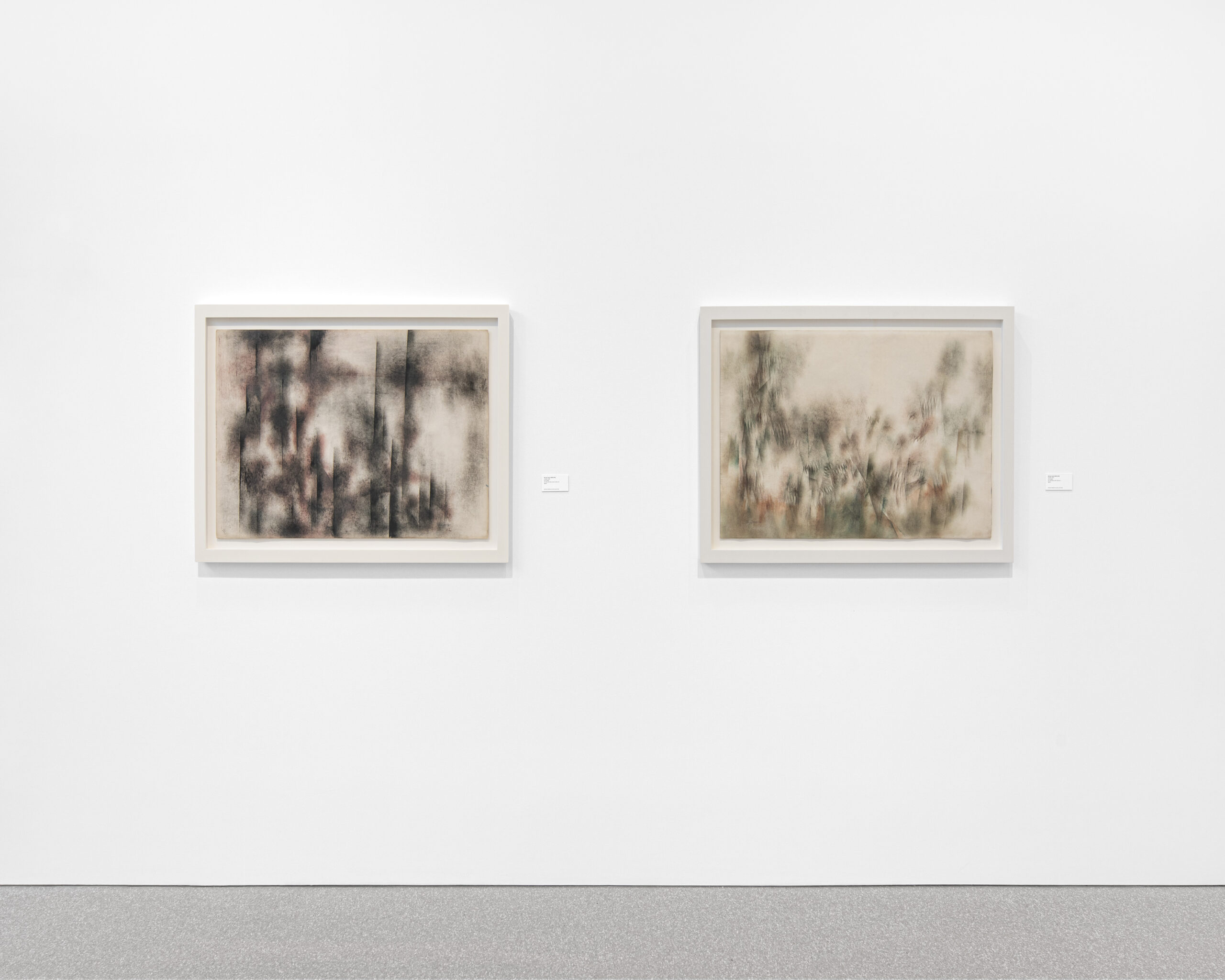
Installation view of “Norman Lewis: Give Me Wings To Fly” at Michael Rosenfeld Gallery, New York, N.Y. (Sept. 7-Nov. 4, 2023). | Courtesy Michael Rosenfeld Gallery


NORMAN LEWIS (1909–1979), Untitled, 1960 (oil on paper, 26 1/8 x 40 inches / 66.4 x 101.6 cm, signed). | © Estate of Norman Lewis. Courtesy of Michael Rosenfeld Gallery LLC, New York, N.Y.


NORMAN LEWIS (1909–1979), “Peep of Day,” 1961 (oil on paper, 26 x 40 inches / 66 x 101.6 cm, signed). | © Estate of Norman Lewis. Courtesy of Michael Rosenfeld Gallery LLC, New York, N.Y.

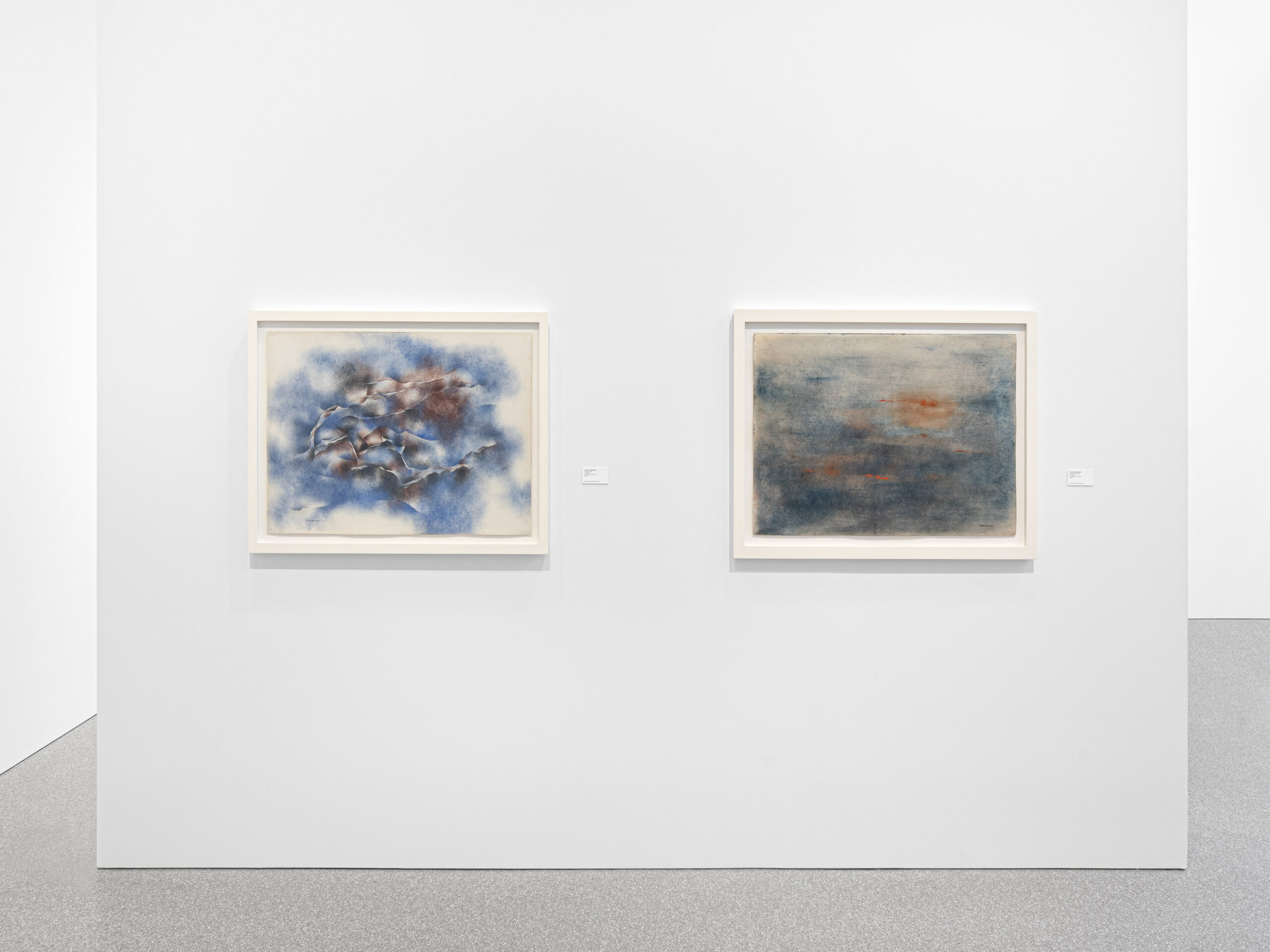
Installation view of “Norman Lewis: Give Me Wings To Fly” at Michael Rosenfeld Gallery, New York, N.Y. (Sept. 7-Nov. 4, 2023). | Courtesy Michael Rosenfeld Gallery


NORMAN LEWIS (1909–1979), Untitled, 1968 (oil on laid paper, 30 7/8 x 42 7/8 inches / 78.4 x 108.9 cm, signed). | © Estate of Norman Lewis. Courtesy of Michael Rosenfeld Gallery LLC, New York, N.Y.


Installation view of “Norman Lewis: Give Me Wings To Fly” at Michael Rosenfeld Gallery, New York, N.Y. (Sept. 7-Nov. 4, 2023). | Courtesy Michael Rosenfeld Gallery

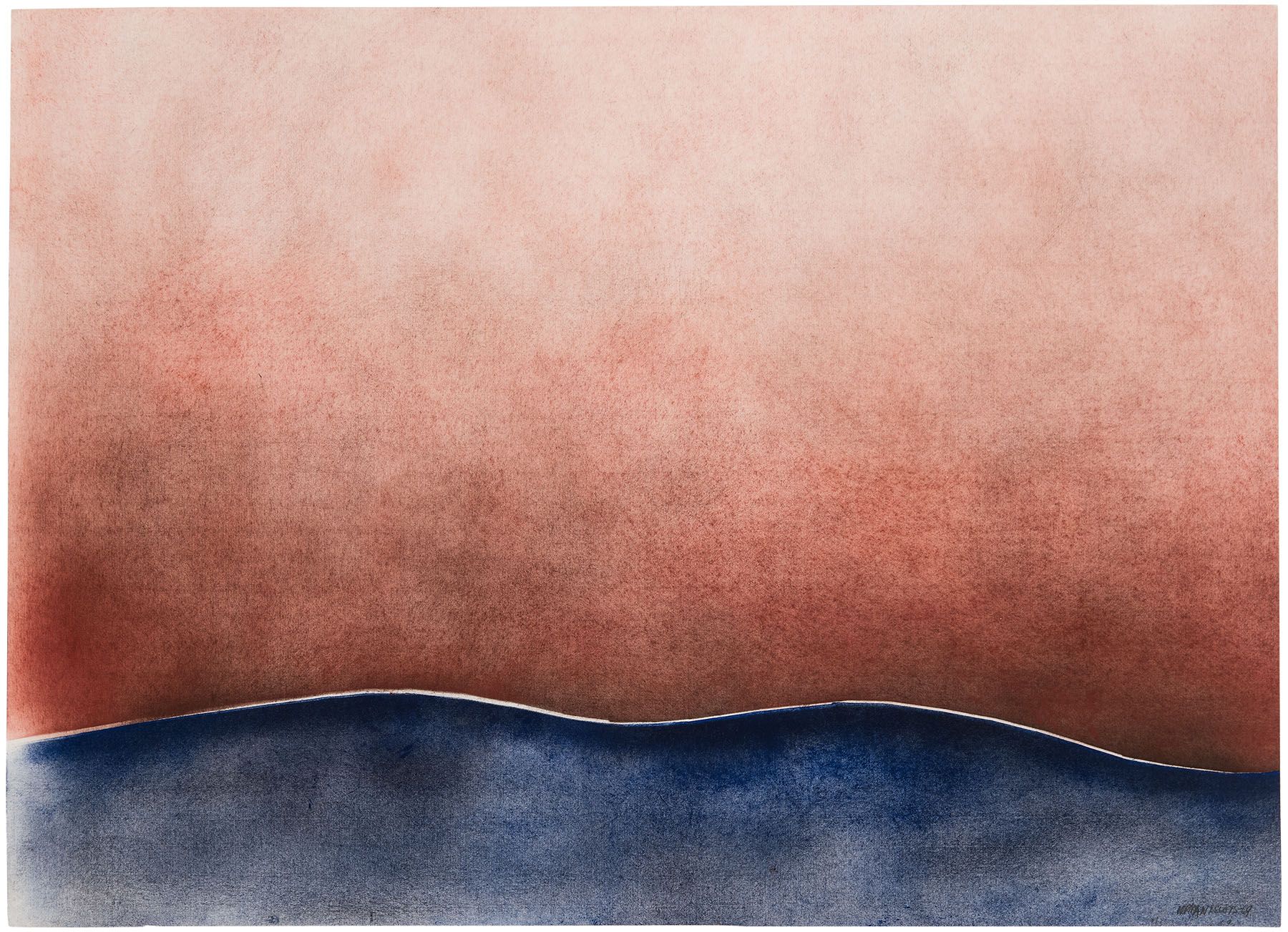
NORMAN LEWIS (1909–1979), Untitled, 1969 (oil on laid paper, 30 3/4 x 42 1/2 inches / 78.1 x 108 cm, signed). | © Estate of Norman Lewis. Courtesy of Michael Rosenfeld Gallery LLC, New York, N.Y.
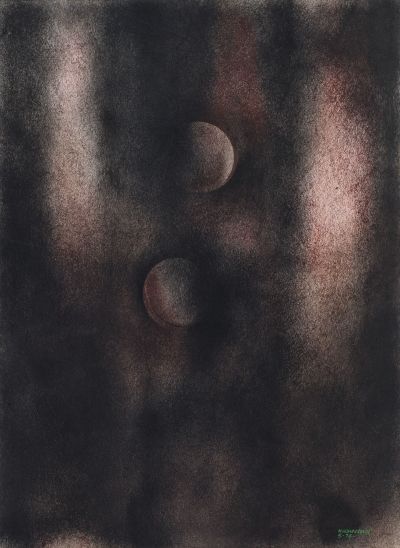

NORMAN LEWIS (1909–1979), “Lights XI,” 1974 (oil on paper, 30 x 22 inches / 76.2 x 55.9 cm, signed). | © Estate of Norman Lewis. Courtesy of Michael Rosenfeld Gallery LLC, New York, N.Y.


NORMAN LEWIS (1909–1979), Untitled, 1974 (oil on paper, 23 x 29 inches / 58.4 x 73.7 cm, signed). | © Estate of Norman Lewis. Courtesy of Michael Rosenfeld Gallery LLC, New York, N.Y.
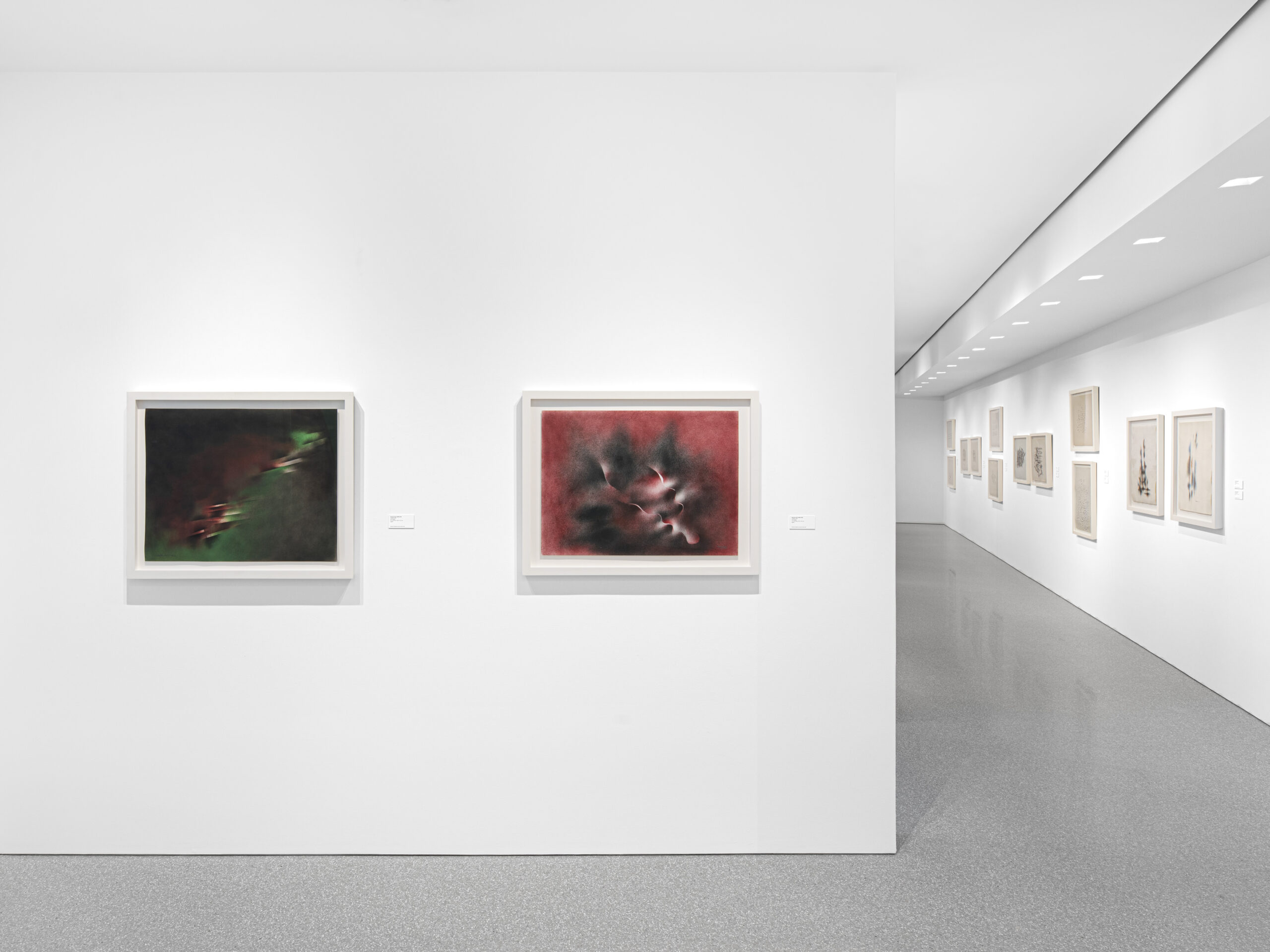

Installation view of “Norman Lewis: Give Me Wings To Fly” at Michael Rosenfeld Gallery, New York, N.Y. (Sept. 7-Nov. 4, 2023). | Courtesy Michael Rosenfeld Gallery

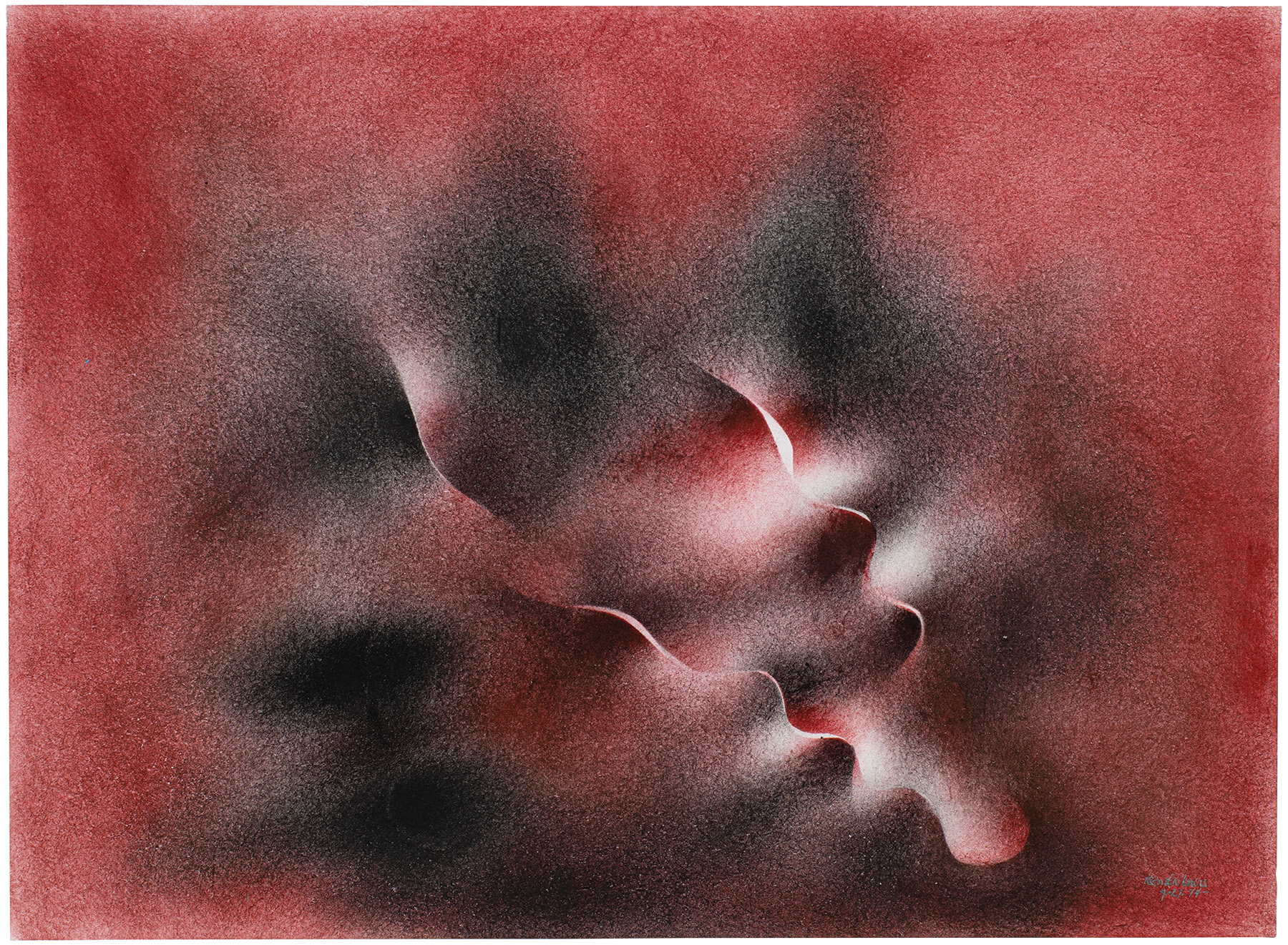
NORMAN LEWIS (1909–1979), Untitled, 1974 (oil on paper, 22 x 30 inches / 55.9 x 76.2 cm, signed). | © Estate of Norman Lewis. Courtesy of Michael Rosenfeld Gallery LLC, New York, N.Y.
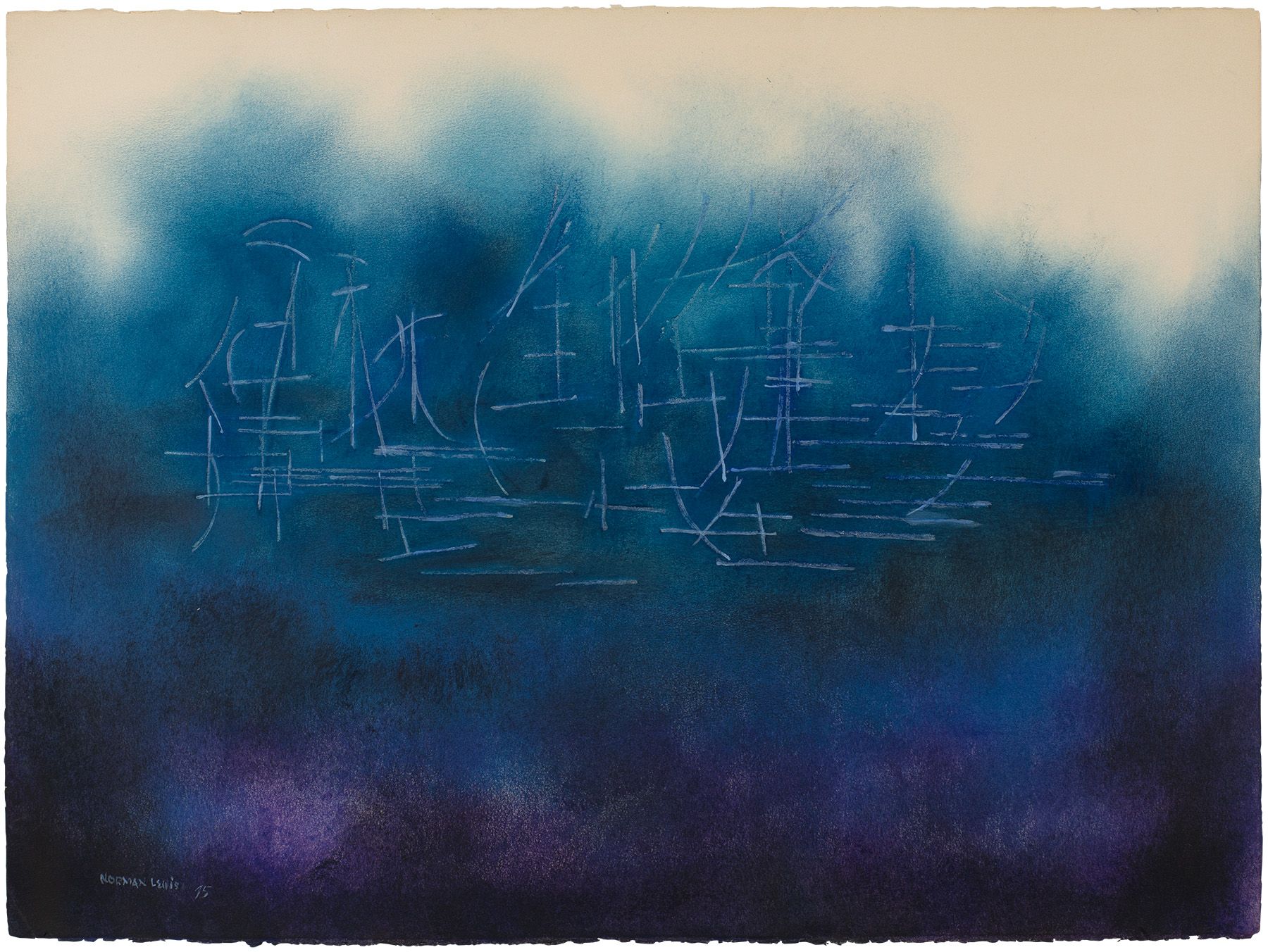
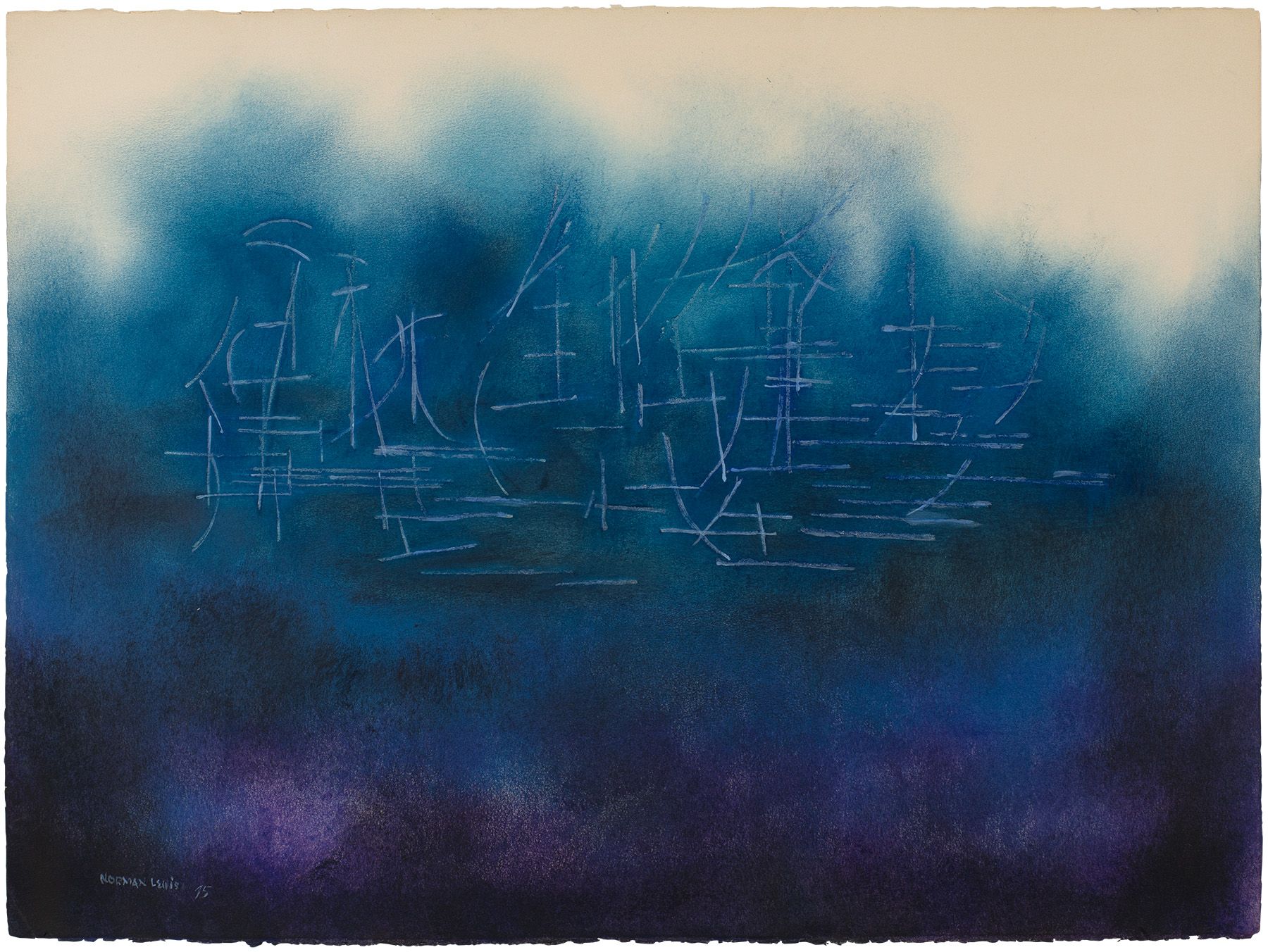
NORMAN LEWIS (1909–1979), Untitled, 1975 (oil on paper, 22 1/2 x 30 inches / 57.1 x 76.2 cm, signed). | © Estate of Norman Lewis. Courtesy of Michael Rosenfeld Gallery LLC, New York, N.Y.
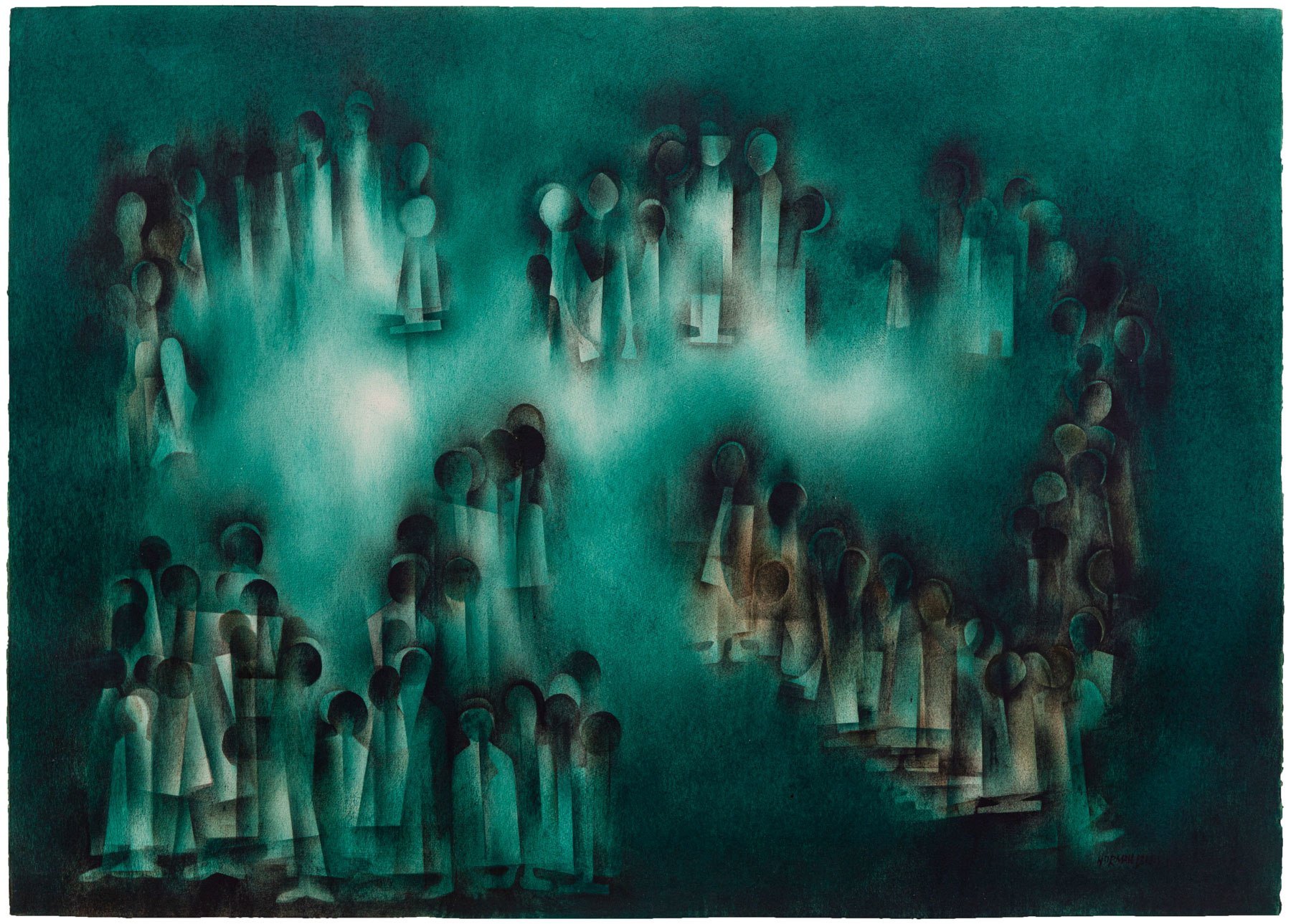

NORMAN LEWIS (1909–1979), “Congregation,” 1978 (oil on paper, 29 5/8 x 41 3/8 inches / 75.2 x 105.1 cm, signed). | © Estate of Norman Lewis. Courtesy of Michael Rosenfeld Gallery LLC, New York, N.Y.

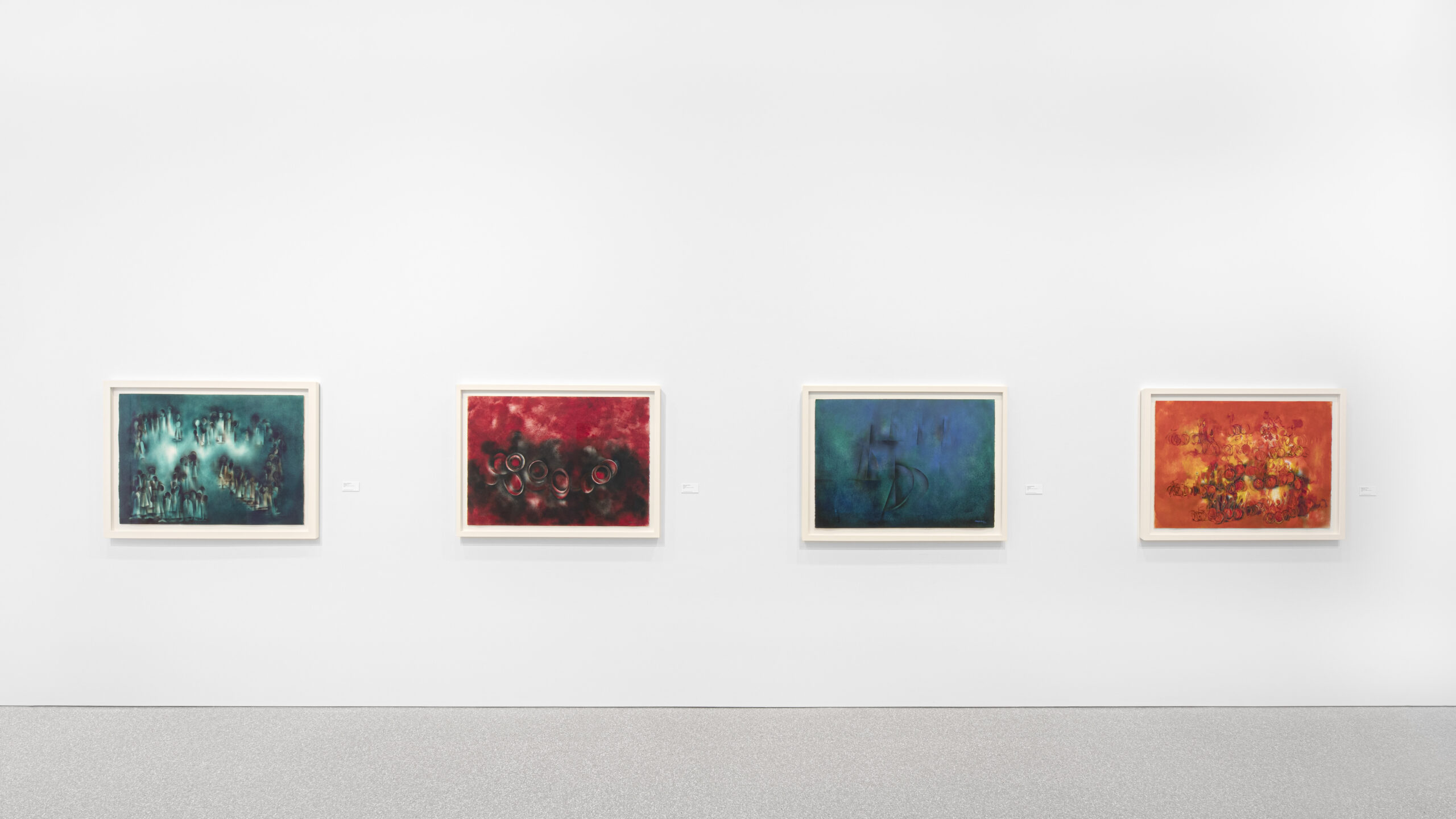
Installation view of “Norman Lewis: Give Me Wings To Fly” at Michael Rosenfeld Gallery, New York, N.Y. (Sept. 7-Nov. 4, 2023). | Courtesy Michael Rosenfeld Gallery
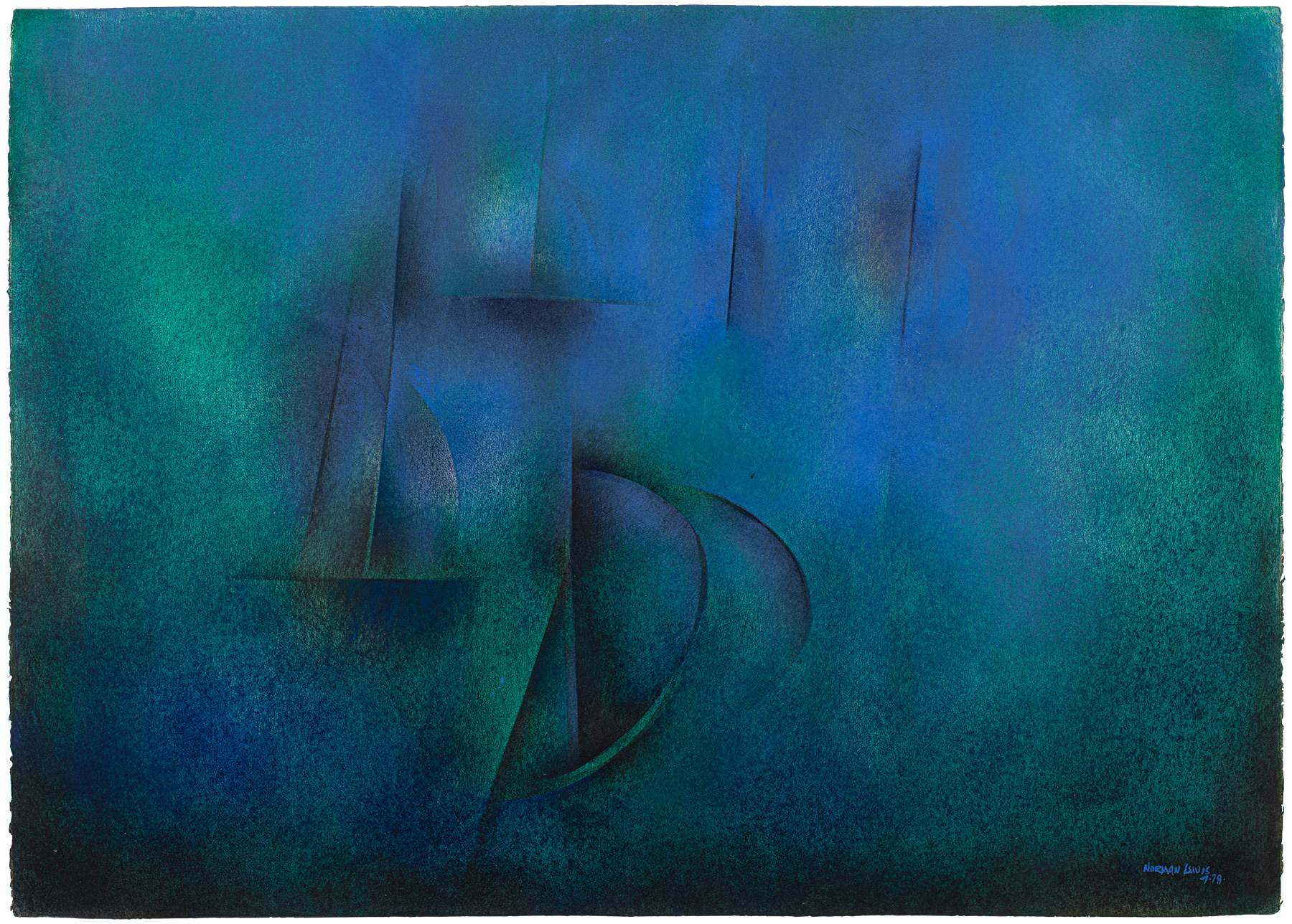

NORMAN LEWIS (1909–1979), Untitled, 1978 (oil on paper, 29 3/4 x 41 5/8 inches / 75.6 x 105.7 cm, signed). | © Estate of Norman Lewis. Courtesy of Michael Rosenfeld Gallery LLC, New York, N.Y.


NORMAN LEWIS (1909–1979), Untitled, 1978 (oil and pastel on paper, 29 1/2 x 41 1/2 inches / 74.9 x 105.4 cm, signed). | © Estate of Norman Lewis. Courtesy of Michael Rosenfeld Gallery LLC, New York, N.Y.
BOOKSHELF
“Procession: The Art of Norman Lewis” by Ruth Fine was published on the occasion of the first comprehensive museum retrospective of Norman Lewis. The volume includes a preface by David C. Driskell and contributions by David Acton, Jeffrey C. Stewart, Jacqueline Francis, Adrianna Campbell, and Helen M. Shannon. Also consider the exhibition catalog “From the Margins: Lee Krasner | Norman Lewis, 1945–1952.” Fine co-authored “Frank Stewart’s Nexus: An American Photographer’s Journey, 1960s to the Present,” the first complete monograph of Frank Stewart, which accompanies a traveling exhibition currently on view at Artis-Naples: The Baker Museum in Naples, Fla. Fine’s “The Art of Romare Bearden” was published in 2003 to accompany the artist’s retrospective at the National Gallery of Art in Washington, D.C., the museum’s first solo exhibition of African American artist, which went on to travel to several other venues. She also contributed to “Romare Bearden: Photographs by Frank Stewart.”

